ISSN ONLINE(2278-8875) PRINT (2320-3765)
ISSN ONLINE(2278-8875) PRINT (2320-3765)
| R.Valarmathi, G.Karthika ME Communication Systems, Department of Electronics and Communication, Agni College of Technology Chennai, India |
| Related article at Pubmed, Scholar Google |
Visit for more related articles at International Journal of Advanced Research in Electrical, Electronics and Instrumentation Engineering
This work suggests the use of RFID technology with Embedded system to provide an improved and efficient automated train ticketing system with RFID tag. An efficient utilization of RFID with Embedded System facilitate the smart ticketing in metro trains is proposed. This system explains the installation of RFID reader circuit in each and every train stations in metro rail to facilitate the calculation of ticket charges. Depending upon the distance(number of stations) travelled, the corresponding cost is automatically deducted from the user’s account. This task is implemented by using an automated Database system which makes the transactions faster, easier and free of ambiguity.
Keywords |
| RFID Tag and Reader, Database system, Embedded system, Ticketing System. |
INTRODUCTION |
| Radio Frequency Identification (abbreviated as RFID) has been an emerging technology in recent years. RFID technology can be effectively employed in number of applications due to its penchant for efficiency. Radio Frequency Identification (RFID) is a generic term for technologies that use radio waves to automatically identify and track product, animal, or person by means of using RFID tags that are applied or incorporated on them. An RFID system consists of a tag, basically a microchip with an antenna and an interrogator or reader with an antenna. A fundamental system of RFID consists of two primary components: The reader circuit and tag. The RFID tag and the reader circuit set up communication via waves of electromagnetic nature. |
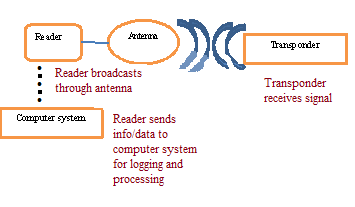 |
| In most RFID tags contain at least two parts. |
| i). First one is an integrated circuit for storing and processing information, modulating and demodulating a RF signal, and other specialized functions. |
| ii). Second is an antenna for receiving and transmitting the signal. |
| The data is stored in RFID tags which respond to the reader by transforming the energy of radio frequency queries from the reader and sending back the information. A computer hosting a specific RFID application pilots the reader and it processes the data it sends. |
II.RFID TAG |
| RFID tags are the components which are uses for the purpose of identification. The tag has a sequential arrangement of metal pins. The most significant feature of this, is the uniqueness exhibited by each of them. Depends on the power source applied to the tag and the maximum range, the tags are divided into: |
| a) Active tag : An active tag has an internal battery circuit that supplies power to magnetize the tag. |
| b) Passive tag : Passive tag is completely dependent on the reader for the required power. |
| The major advantage of the use of this active tags is that these tags can broadcast the signals efficiently up to a distance of 100 feet whereas the latter is limited to a maximum distance of 200 feet. The tags can further be classified depending on the signal transmitted. The active tags transmit signals independent of the reader, whereas passive tags are completely dependent on the signal from the reader to transmit information . |
III.RFID READER |
| The unique digital data of the tag is decoded with the help of RFID reader. The RFID reader transmits an electromagnetic wave which is the input to the tag. The unique arrangement of metallic pins is energized due to these electromagnetic waves. It results in the production of a confined magnetic field. The confined magnetic field has an interference pattern which is again unique to each metallic arrangement of the tag. This interference pattern which when read by a RFID reader would produce the unique number assigned to the RFID tag and thus the address of the tag is obtained . It should be noted that the address defers from each RFID tag and hence it offers complete resistance to duplication . |
| With respect to the concepts of RF Identification discussed above, the use of the same technology in the ticketing system would induce an enhanced transparency and offer a suitable platform for preventing any fraudulent practices. |
IV.TERSE INTRODUCTION |
| The primary requirements for the implementation of ticketing system using RFID are: |
| i) RFID tags and reader circuit. |
| ii) Database system |
| iii) door controlled by the system. |
| The main advantage of the RFID tag is that each tag has a unique sequence number and hence there is no possibility of duplication . Also, the cost of manufacturing a RFID tag is appreciably less. Hence it makes the availability of RFID Tags to the public a viable option. For the implementation of this ticketing system, a common database system should be maintained by the designated authorities . The common database has information about its entire registered users. The users should recharge their account with a certain “minimum” credit from any "Value added machine", that would be installed by the concerned authorities. |
| The RFID tag is such designed that it has all the information regarding the users account which is being maintained in the database (which includes the credit) . The deployment of the suggested system would also greatly reduce the prevalent malpractice and hence would discourage the authorities from any fraudulent practice. |
V.PROPOSED SYSTEM |
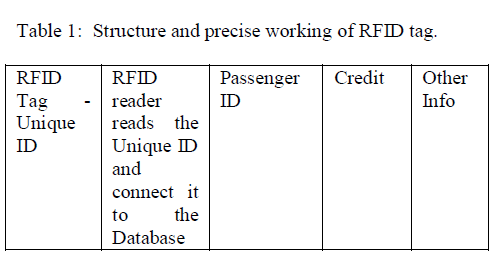 |
| Passengers entering into the railway station, they need to swipe the RFID tag to open the gate to entering into the concern platform. Once the tag is placed in front of the RFID reader circuit, the latter energizes the tag and reads the unique digital data stored it. Then the tag reveals relevant information to the reader circuit. The RFID reader will have the internal memory, which stores the information about the RFID tag and it also links it to the Common Database. The Display in the RFID reader will display the Source and balance information. When the customer reaches the destination, they need to swipe the card to leave from the platform. If the customer have low balance in his card, there may be a "Value Added Machine" available in that platform itself can added the value. |
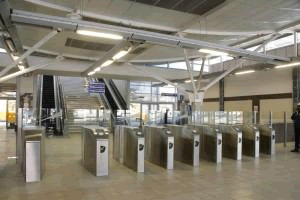 |
| In this proposed system, the passengers need not to wait in the ticket counter to get the ticket. It saves the time for the passengers. By this system, we can reduce the fraudulent activities and accidents. |
VI.GENERAL LAYOUT OF RFID SYSTEM INSTALLED IN THE TRAIN |
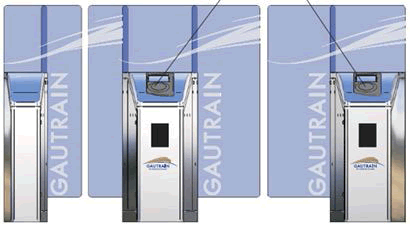 |
| The RFID reader circuit is installed at the entry point and at the exit of the platform gate . When the passenger enters the platform gate , the passenger should display the tag in front of the reader circuit placed at the platform gate. Similarly, the passenger, while getting down at the desired station, should display the tag in front of the reader circuit placed at the exit point. The platform door will open while entering and leaving from the platform. The cost equivalent to the distance travelled by the user is hence calculated and the same is updated in the common database system. The detailed operation of the system is further explained below. |
VII.OPERATIONAL PRINCIPLE |
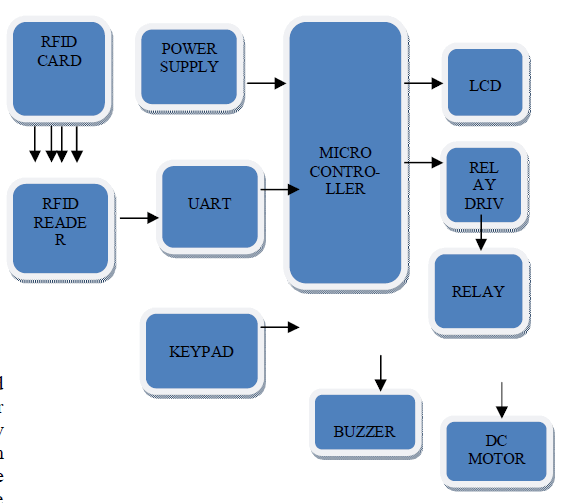 |
| The passenger entering the platform should display/place the RFID tag in front of the reader ). When the tag is placed before the reader circuit, the tag gets energized and the reader reads the unique digital data behind it. Hence the tag reveals relevant information to the reader circuit. The reader circuit stores this information in its internal memory temporarily and also links to the common database system which has all the details of the particular passenger. If the information's are correct then the door will open. If the user don’t have the enough balance then the alert tone will be given by the buzzer. |
 |
| As mentioned previously, instead of each and every user manually entering the point of entry and destination, the user just has to place the tag before the reader circuit while entering and getting down at the destination station. |
| It should be noted that the database system has programmed information regarding the fare deduction corresponding to the distance travelled by the user . When the passenger displays the tag in front of the reader while getting down, the reader (which has previously stored the information regarding the same tag/user) equates the fare corresponding to the distance travelled by the passenger . Hence the fare corresponding to the distance travelled by the passenger is deducted from the user’s account and the same is updated in the common database . |
ACKNOWLEDGMENT TO THE USER: |
| The travel/transaction details will be instantly sent to the user with the use of GSM via Simple Mail Service (SMS). This notification is done with the help of the database system which has the contact details of all its registered users. Hence whenever a transaction is carried out using the tag, the database system automatically transfer the information to the concerned user. This would allows the user to know about their travel and transactions details. |
FOR LOST TAGS: |
| As mentioned previously, each RFID tag has a unique id. The proposed system is designed that the user can be assigned with a new unique id if the person loses the tag. This can be done by the information provided by the user to the authorities. The authorities restore the information of the user in the database system to the new unique RFID tag which the user can use for their future transactions. |
ADVANTAGES: |
| The proposed model of ticketing system would reduce the complexity of the passengers In this proposed system, the passengers need not to wait in the ticket counter to get the ticket. It saves the time for the passengers. By this system, we can reduce the fraudulent activities and accidents. |
| Because of the existing system the passengers faced more problems like waiting in the line, missing the train and so on. In the existing system, the users should manually enter the place of entry and destination. But in this proposed system, the users need not manually enter the place of entry and destination. Instead of that, the user just place his unique RFID tag in front of the reader while entering and leaving the platform and corresponding fare is deducted from the user’s account and the door will opened. Hence the whole system is fully automated and reduces the complexity. |
| In comparison with the old system (printed tickets), the proposed model would induce several advantages. The conventional system uses tickets made by paper. These paper tickets are printed everyday on a large scale to meet the requirements. “Global warming” and deforestation is the primary reason behind it. The proposed model would greatly reduce these disadvantages and also would prevent the fraudulent practices which gives great losses to the government. Considering the advantages of RFID technology, the RFID tags have almost 100% read rate. It is known that the RFID tag and reader communicate via transmission of radio waves. |
VIII.CONCLUSION |
| The proposed ticketing system is presented in this paper, the operation would be fully automated, efficient, enhanced and cost-effective. The proposed system can also be implemented in other places like toll gates , bus ticketing and others. The efficiency of the RFID system, as mentioned in this paper, would make the implementation practical and effective. |
References |
|